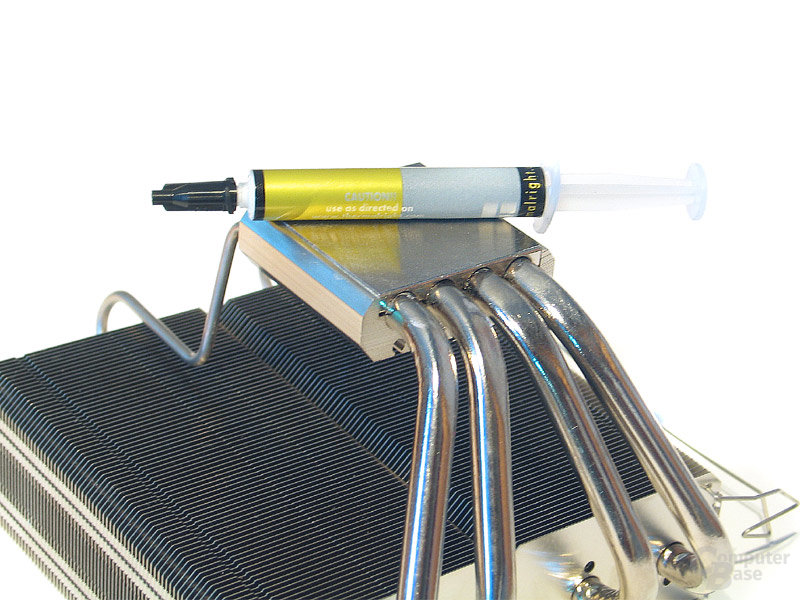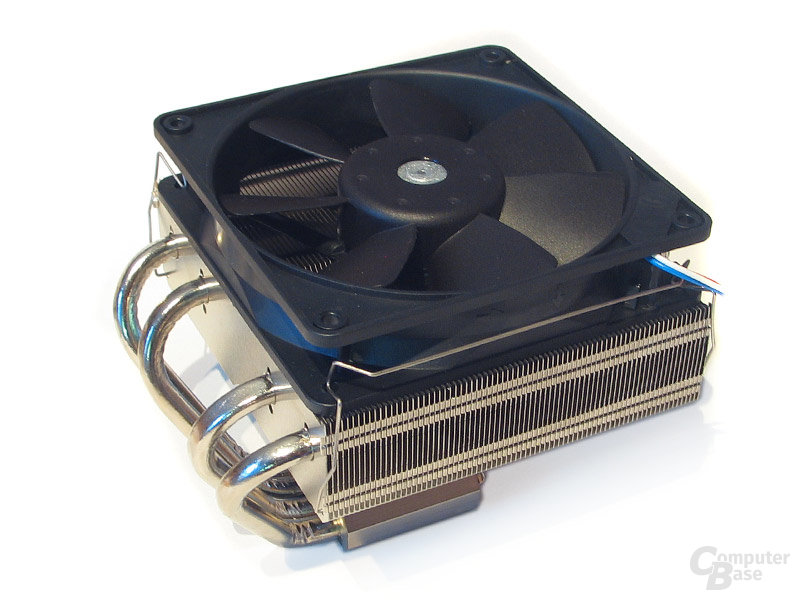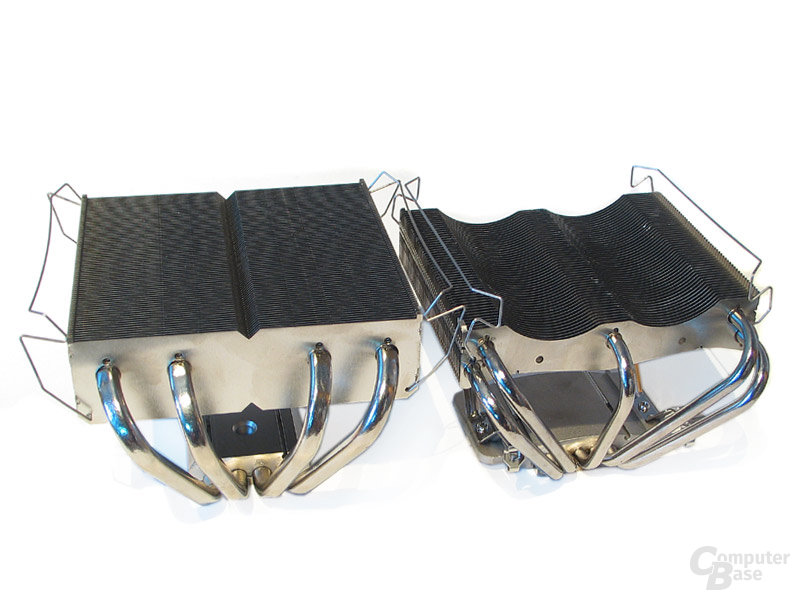After Thermalright launched a first-class CPU cooler with the SI-120 (tested 15 years ago), an improved model followed with the SI-128 (test), the cooled even better. As is typical for Thermalright, the SI-128 was sold without a fan and had a comparatively high price at 55 euros.
Table of contents
- < li> 1 Larger heat sink with narrower fins
- At high speeds, the SI-128
- Conclusion
Larger heat sink with narrower fins
The dimensions of the Thermalright SI-128 were 150 × 125 × 91.5 mm and weighed 510 g. For the model, the manufacturer used a copper base plate to absorb the waste heat from the processor and an aluminum heat sink. Four 8 mm heat pipes were used to transport heat between these two components. Compared to the SI-120, the number of slats increased from 52 to 78, while the distance between the slats fell from 1.5 to 1.0 mm.
-
 Thermalright SI- 128 Scope of delivery
Thermalright SI- 128 Scope of delivery
Image 1 of 9
 Thermalright SI-128 scope of delivery
Thermalright SI-128 scope of delivery  Thermalright SI-128
Thermalright SI-128  Thermalright SI-128
Thermalright SI-128  Thermalright SI-128 with Papst fan setup
Thermalright SI-128 with Papst fan setup 
 Significantly more massive compared to the predecessor (SI-120 right)
Significantly more massive compared to the predecessor (SI-120 right)  4-way 8 mm heat pipe instead of 5-way 6 -mm structure
4-way 8 mm heat pipe instead of 5-way 6 -mm structure  Compatibility problems cannot be identified
Compatibility problems cannot be identified  Powerful contact pressure bends the mainboard
Powerful contact pressure bends the mainboard In terms of assembly, the SI-128 had some problems, at least when the cooler was to be mounted on a mainboard with a 775 socket. On the one hand, the expansive cooler covered the push pins, and on the other hand, the contact pressure of the cooler was so high that the mainboard bent under the tension. These two factors together ensured that the mainboard had to be removed from the case for the cooler installation. With boards with an AMD socket, however, there were no problems, because the retention module developed by AMD ensured simple and uncomplicated assembly.
At high speeds, the SI-128
is worthwhileIn the test, the Thermalright SI-128 and SI-120, the Scythe Ninja, the Zalman CNPS 9500 and Intel's boxed cooler had to hold their own on a hot-headed Pentium Extreme Edition 840. The idea behind the processor choice: The cooler that can cool a Pentium EE 840 can also handle an energy-saving Core 2 Duo. Due to the larger cooling surface, the SI-128 was able to set itself apart from the SI-120, especially at higher speeds. While the difference was 2 Kelvin at 496 rpm, it was 4 Kelvin at 1,145 rpm and 4 Kelvin at 1,532 rpm. Thus the Thermalright SI-128 delivered a good cooling performance, but did not come close to the Scythe Ninja. Depending on the speed, this could sit between 3 and 8 Kelvin in front of the SI-128.
CPU cooler in performance comparison Unit: ° C
- Scythe Ninja [Coolink 1556 rpm]:
- Load temperatures63.0
- Idle temperatures40.0
- Volume in dB (A) 44.2
- Scythe Ninja [Pope 1187 rpm]:
- load temperatures66.0
- idle temperatures41.0
- volume in dB (A) 36.7
- Thermalright SI-128 [Coolink 1532 rpm]:
- Load temperatures66.0
- Idle temperatures41.0
- Volume in dB (A) 44.1
- Scythe Ninja [Pope 542 rpm]:
- load temperatures68.0
- idle temperatures43.0
- volume in dB (A) 30.8
- Thermalright SI-120 [Coolink 1532 rpm]:
- Load temperatures70.0
- Idle temperatures41.0
- Volume in dB (A) 44.1
- Zalman CNPS 9500 LED [2451 rpm]:
- load temperatures70.0
- idle temperatures41.0
- Volume in dB (A) 52.9
- Thermalright SI-128 [Papst 1145 rpm]:
- load temperatures70.0
- idle temperatures42.0
- volume in dB (A) 36.6
- Zalman CNPS 9500 LED [1365 rpm]:
- load temperatures72.0
- idle temperatures44.0
- Volume in dB (A) 36.2
- Thermalright SI-120 [Pope 1145 rpm]:
- load temperatures74.0
- idle temperatures43.0
- volume in dB (A) 36.6
- Thermalright SI-128 [Pope 496 rpm]:
- load temperatures76.0
- idle temperatures45.0
- Volume in dB (A) 30.7
- Intel Boxed without PWM [2325 rpm]:
- load temperatures77.0
- idle temperatures46.0
- volume in dB (A) 49.5
- Thermalright SI-120 [Pope 496 rpm]:
- Load temperatures78.0
- Idle temperatures47.0
- Volume in dB (A) 30.7
- Intel Boxed without PWM [1604 rpm]:
- load temperatures84.0
- idle temperatures50.0
- Volume in dB (A) 37.9
Conclusion
The Thermalright SI-128 was able to convince in the test with a high cooling performance, even if it did not quite achieve the performance of the best tower coolers. But it had a decisive advantage: As a top blow cooler, components such as the voltage converters and the chipset were also cooled by the air flow facing the mainboard. These components could get very hot, especially in the case of tower coolers that were equipped with slowly rotating fans. How often should the cooler be installed and uninstalled and could problems arise from bending the mainboard? Those were the questions that owners of motherboards with an Intel socket had to ask themselves. Due to the comparatively high price of 55 euros plus the cost of a fan, the Thermalright SI-128 was not recommended 15 years ago.
In the “Tested 15 years ago” category, the editorial team has been looking into the test archive every Saturday since July 2017. The last 20 articles that appeared in this series are listed below:
- Microsoft WHQL torpedoed Nvidia's Quad-SLI
- An overclocked GeForce 7600 GS with 512 MByte memory
- Intel's Core 2 Duo E6600 and E6700 cleaned up with AMD
- The absolute price-performance tip GeForce 7600 GST
- The Zalman VF-900 Cu dominated them all
- Three GeForce 7950 GX2 from loud to fast
- GeForce custom designs in extra fast and silent
- The “gamer cube” that only ventilated via the power supply
- Nvidia's double decker alias GeForce 7950 GX2
- Intel's Core 2 Duo E6700 shone in the preliminary test
- Nvidia's nForce 500 for AMD's AM2 socket with DDR2 RAM
- The best Radeon X1900 XTX came with a Zalman cooler
- PCIe x8 versus PCIe x16 for multi-GPU systems
- PhysX accelerator for 299 euros from Ageia
- The GeForce 7600 GS was a stunner for 125 euros
- HTPC housing from Lian Li and Silverstone
- The GeForce 7900 GTX in 90 nm and with a higher clock rate
- Creative Sound Blaster X-Fi for more audio quality and FPS
< li> The Core 2 Extreme X6800 left everyone behind
< li> ATi's X1900 GT bit its teeth on Nvidia's 7900 GT
Even more content of this kind and many more reports and anecdotes can be found in the retro corner of the ComputerBase forum.

